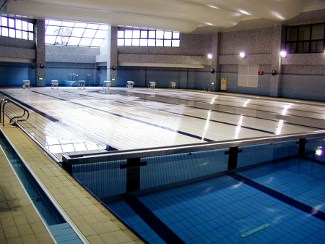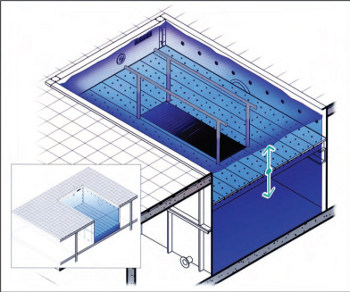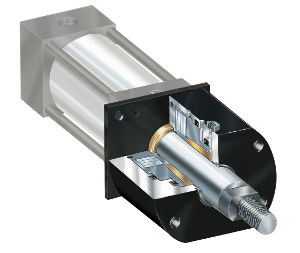 |
| April 10, 2012 | Volume 08 Issue 14 |
Designfax weekly eMagazine
Archives
Partners
Manufacturing Center
Product Spotlight
Modern Applications News
Metalworking Ideas For
Today's Job Shops
Tooling and Production
Strategies for large
metalworking plants
Engineer's Toolbox:
Movable pool bottom relies on hydraulic rod locks

The AFW pool-raising and -lowering system, designed by Aquatic Development Group, operates on a series of hydraulic rams connected by a rebar structure to evenly and smoothly raise and lower the pool floor.
Aquatic Development Group (ADG) of Cohoes, NY, is a professional design, manufacturing, and construction firm serving the waterpark, resort, hotel aquarium, aquatic therapy, and commercial/institutional swimming pool markets. The company's recreational aquatic creations range from Disney to the Wisconsin Dells, plus a diverse group of institutional and physical-therapy applications are included in the company's successes. Among ADG's many unique designs is the AFW movable pool floor system that allows depth adjustment from deck level down to deeper water for various uses, including physically challenged patient aquatic therapy. The system is also used routinely in pools adapted for competitive swimming, diving, water polo, and other activities where the depth adjustment is beneficial and allows more multi-purpose use of a facility.
At the touch of a button on the master control module, the pool floor is raised and lowered by a system of synchronized multiple hydraulic cylinders that work to maintain consistent floor level throughout the process. ADG determined it was necessary to include a mechanical locking system that would secure the cylinder rods in position, at all points of travel, especially when the floor was occupied by physical-therapy patients, water aerobics participants, etc. The floor also features a passive mechanical pulley system to maintain the floor position in the event of a catastrophic hydraulic failure.

Illustration of pool bottom showing AFW design of stainless steel and non-skid PVC flooring.
Ithaca College (Ithaca, NY) recently had the system installed. "We had a four-cylinder ram system with a rebar structure that was designed so that any two diagonally opposed cylinders could malfunction without compromising the stability or safety of the floor and its occupants," says ADG Engineering Manager Rob Schiavi. The company developed a special 304L stainless steel and non-skid, chemically impervious PVC floor grating that was considerably lighter weight but somewhat less stable than conventional concrete pool flooring.
The hydraulic circuits operate on a shuttle valve system with passive-engage ram failure. Eliminating the mechanical pulley system on the design results in a smoother transitioning of the pool floor level, particularly important when people are present, says Schiavi.
When designing the hydraulic ram system and an appropriate cylinder-locking protection system, ADG turned to its local subcontractor, who recommended the Amlok system of hydraulic cylinder rod locks from Advanced Machine & Engineering (Rockford, IL), a long-time supplier of hydraulic and pneumatic rod locks to industrial and commercial applications worldwide. AME Business Development Manager Ken Davis explains, "We saw this project as an ideal application for our hydraulic rod locks, with one particular challenge, namely, the ingestion of chlorinated pool water." To overcome this challenge, a modification was made to the seal design and materials on the four stainless steel rod locks, which were installed on the ram system built by ADG's subcontractor. Each lock has the capacity to provide a locking force to 50,000 lb at 1,500 psi release pressure.
During normal operation, the RCH Series hydraulic rod locks used on this application allow free movement of the cylinder through the lock housing, as the supplied hydraulic pressure maintains an open position on the lock. When the desired pool floor level is achieved, the hydraulic pressure is removed and the cylinder is mechanically locked into position. However, in the event of a catastrophic power loss or other hydraulic system failure, when the pressure is removed, the lock immediately clamps to retain the cylinder securely in its present position until power is restored and the lock release is again activated.
AME worked closely with its local distributor, Airline Hydraulics Corp. (Bensalem, PA), to supply this system to ADG.

RCH Series AMLOK Hydraulic Rod Locks hold cylinders in place and automatically seize cylinders in position, in the event of a catastrophic power loss.
More about the AMLOK rod locks The AMLOK Hydraulic Series RCH Rod Lock has been developed to provide power-off clamping of rods and shafts. The type RCH Rod Locks are actuated by a spring/collet mechanism and unclamped by hydraulic pressure. These rod clamps are designed to clamp components after the motion has stopped and to hold the position securely as long as the forces do not exceed the table values.
The mountings of the RCH AMLOK Rod Lock have been designed to apply to standard, heavy-duty NFPA-style MF1 cylinders. The standard housing can be mounted to any machine structure or be custom-designed to suit your application.
The AMLOK Rod Lock consists of an alloy steel housing (special materials available on request) containing a special locking mechanism actuated by a set of disc springs. The clamp is unlocked when hydraulic pressure actuates a piston that compresses the disc springs and releases the locking device.
Since the locking of the AMLOK Rod Lock is accomplished mechanically and unlocked by hydraulic pressure, loss of hydraulic pressure to the rod clamp will cause the unit to lock.
The holding force depends upon the rod diameter and the amount of hydraulic pressure (PSI) available for unclamping. The AMLOK is preset at the factory to release at the specified hydraulic pressure. These rod locks are designed for locking axial motions only and are designed for zero side loads. When side loads are acting on the cylinder rod, make sure that the rod is guided sufficiently in bearings to avoid side loads on the locking mechanism. This is especially important at higher cylinder rod speeds to avoid overheating the clamping device due to excessive friction with the rod.
Click for more information on Amlok hydraulic cylinder rod locks from AME.
Published April 2012
Rate this article
View our terms of use and privacy policy
